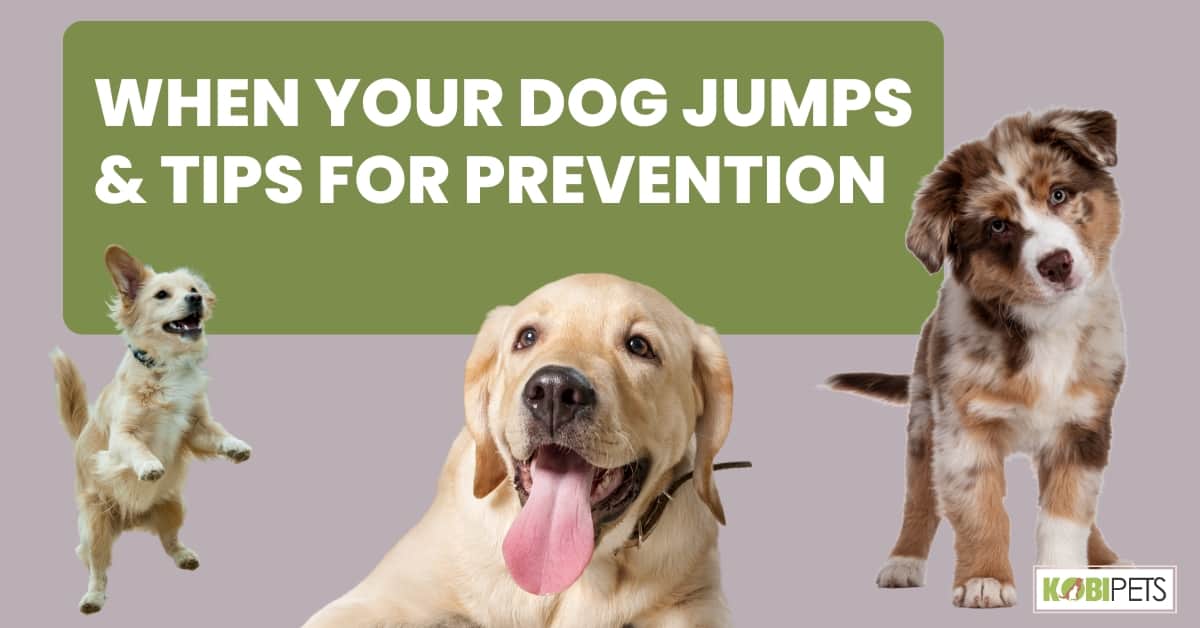
For many pet owners, having an overly eager pup who jumps on visitors and other dogs can be both embarrassing and undesirable. Luckily, there are steps that can be taken to help your pup learn appropriate behavior and to discourage jumping.
Training your dog to prevent jumping requires consistency, patience, and positive reinforcement. Reinforce alternative behaviors such as sitting, eye contact, and going to a mat. Socialize your dog by exposing them to new people, places, and experiences in a controlled environment.
Keep reading for more tips on preventing your pup from jumping – a solution may be simpler than you think!
Understanding why dogs jump
Understanding why dogs jump is a crucial step in preventing this behavior. Jumping is a natural and instinctual behavior for dogs. They often use jumping to greet their owners or to assert dominance. In some cases, dogs may jump as a form of play or excitement.
However, jumping can also be a problematic behavior that can cause injury to both the dog and its owners.
It’s important to understand that jumping is a learned behavior that is reinforced through positive attention or threats. If a dog jumps and receives attention from their owner, it will continue to jump in order to receive the same positive reinforcement.
On the other hand, if a dog jumps and is ignored or scolded, it may stop jumping or start jumping even more in an attempt to receive attention.
In order to effectively prevent jumping, it’s important to understand why your dog is jumping and what triggers the behavior. This information will help you tailor a training plan that is specific to your dog’s individual needs and habits.
With patience and consistency, you can teach your dog to curb its jumping behavior and to engage in alternative behaviors that are safer and more appropriate.
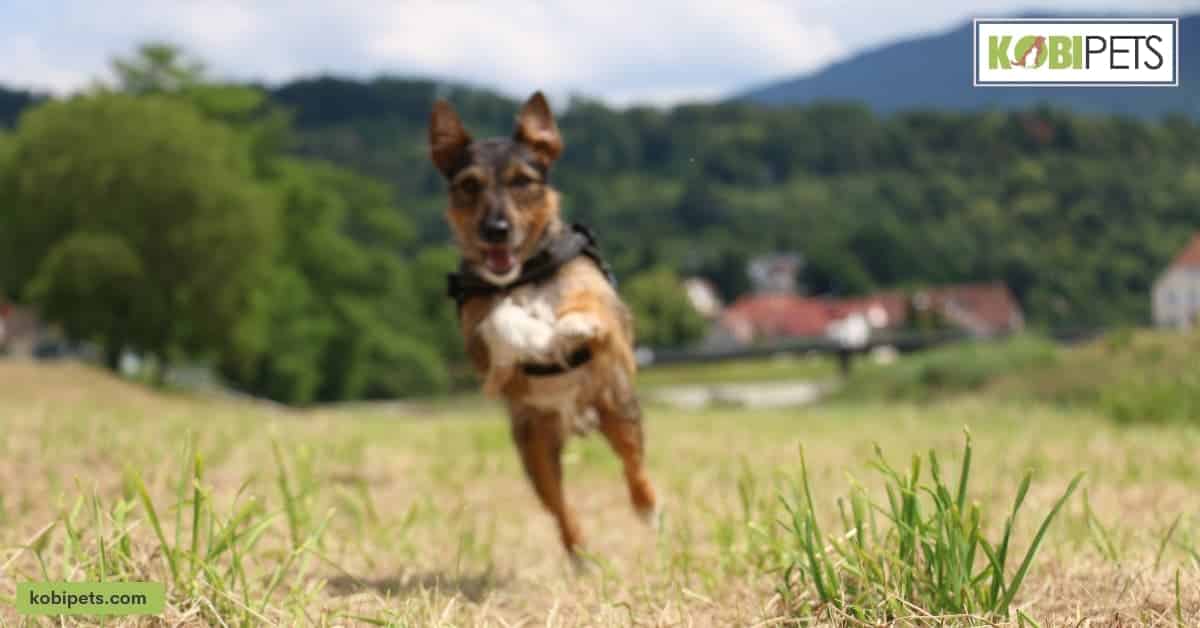
The dangers of a dog jumping
Jumping is a common behavior among dogs, but it can also be dangerous. While it may seem harmless or even cute, jumping can cause physical injury to the dog and others, lead to aggressive behavior, and limit socialization opportunities.
The dangers of dog jumping include:
- Physical injury to the dog: Jumping can cause strain on a dog’s joints, ligaments, and bones, particularly in older or overweight dogs. Over time, this can lead to long-term health problems such as arthritis.
- Physical injury to others: A jumping dog can cause injury to people, particularly children and elderly individuals, by knocking them over or scratching them with their claws.
- Damage to property: A jumping dog can cause damage to furniture, walls, and other household items.
- Aggression: Dogs that jump can become aggressive, particularly if they are jumping to assert dominance or if they are being scolded for jumping.
- Fear and anxiety: Dogs that jump may cause fear and anxiety in other dogs or people, which can lead to further behavioral problems.
- Reduced socialization opportunities: Dogs that jump can be difficult to control in social situations, which can limit their ability to interact with other dogs and people.
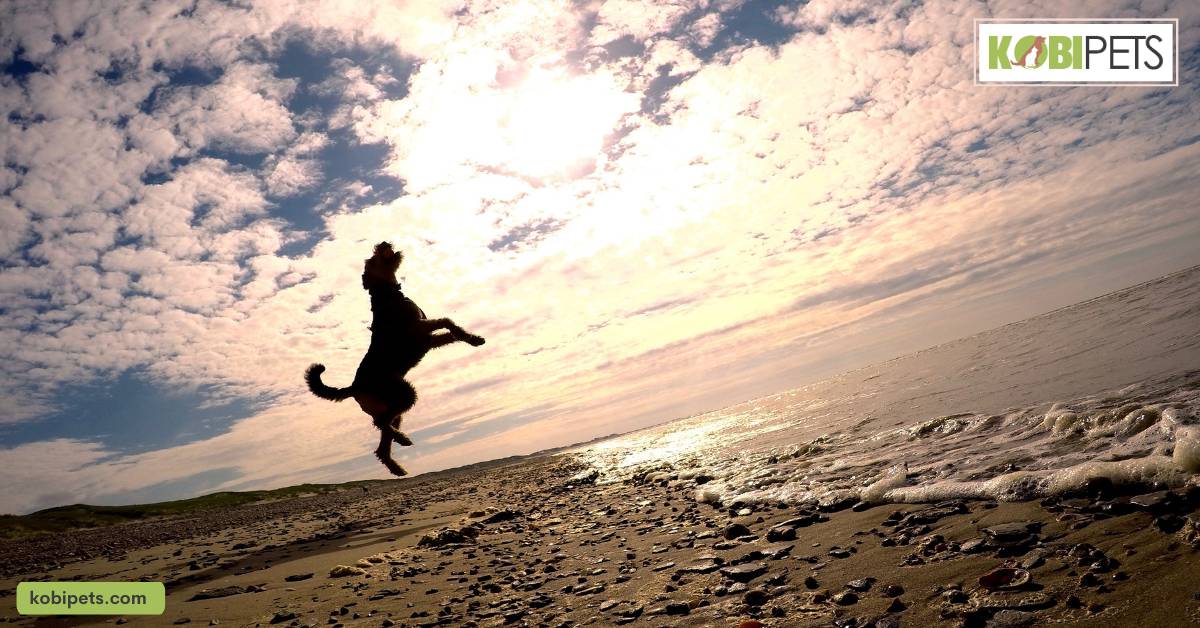
Training techniques to prevent jumping
Jumping is a natural behavior for most dogs and can quickly become an annoying or dangerous habit.
Training techniques are available to help prevent jumping, allowing pets and their owners to interact without fear of injury or fear of creating negative behaviors in the dog.
1. Set Boundaries: Establish clear boundaries and expectations for your dog when it comes to jumping, such as no jumping on people or furniture. Make sure everyone in the household understands these boundaries and is consistent with enforcing them so that your pup knows what to expect.
2. Reward Good Behavior: Praise and reward your pup when they display the behaviors you want to see, such as sitting calmly instead of jumping. Providing treats and affection when your pup does something good will reinforce the desired behavior and help discourage jumping.
3. Redirect Attention: When you notice your dog getting overly excited or about to jump, try to redirect their attention away from the situation by giving them a toy to play with or asking them to sit before getting their attention.
4. Use Leashing: Attaching a leash to your pup can help you keep control and prevent jumping if your pup gets too excited. Make sure the leash is loose enough so that it doesn’t choke your pup but tight enough so that they can’t jump.
5. Provide Exercise: Make sure your pup gets enough exercise every day to help them expend their energy and stay focused on you. Providing regular exercise can help prevent jumping because it gives your pup an outlet for their energy and helps keep them mentally stimulated.
6. Practice Training: Incorporate regular training into your pup’s routine to help them understand what behavior is expected of them and prevent jumping. Use positive reinforcement techniques such as reward-based training and consistent commands to reinforce the desired behavior.
7. Socialize Responsibly: Socializing with other dogs can also help curb jumping because it teaches your pup proper manners around other animals. However, make sure to do it responsibly and in a controlled setting such as an obedience class or dog park where they can learn to interact without jumping on people.
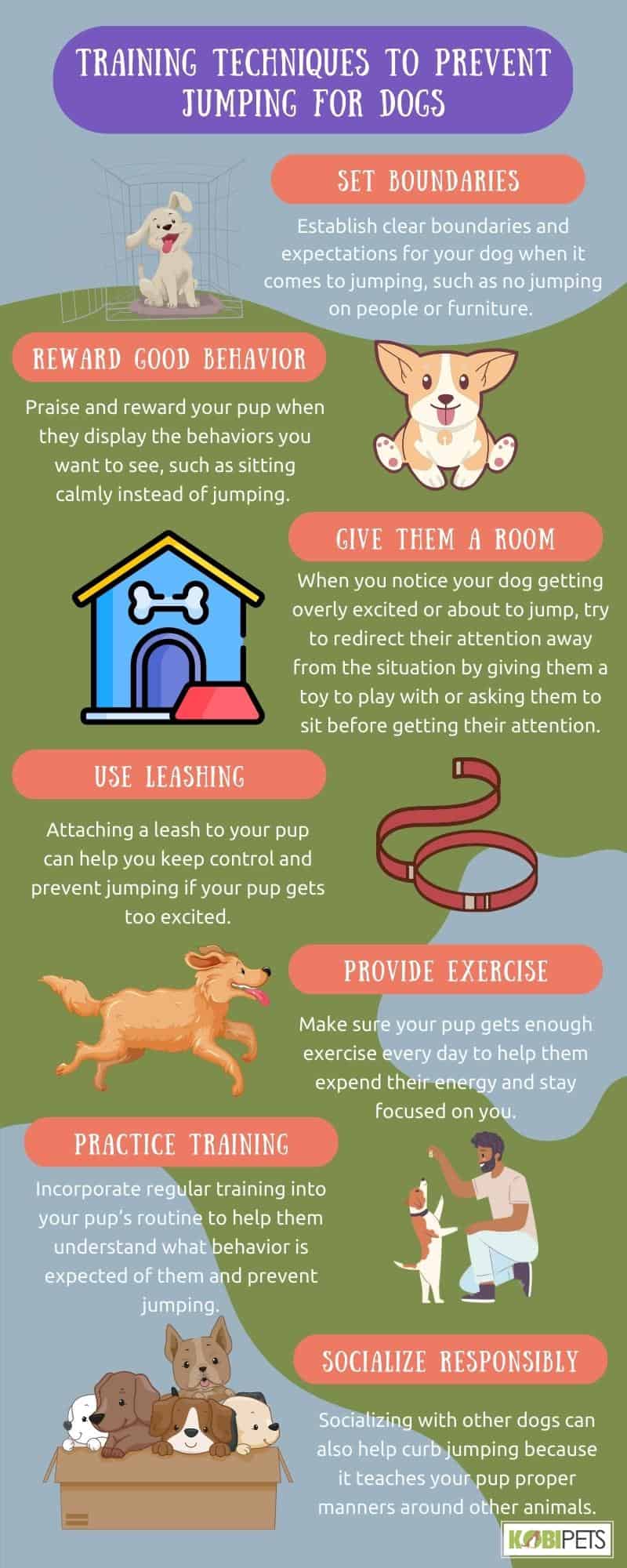
Training techniques to prevent jumping
Consistency and patience in training
Consistency and patience are key components in effectively training a dog to prevent jumping.
It means using the same commands and techniques every time your dog tries to jump. Patience involves giving your dog the time and space to learn. It understands the new behaviors you are trying to teach.
Training a dog to stop jumping requires time and effort, but consistent and patient training can help you achieve your goals.
It’s important to avoid punishment or physical force, as this can cause fear or anxiety in your dog and make the jumping behavior worse. Instead, use positive reinforcement techniques such as treats, praise, and petting to encourage good behavior.
When training your dog, it’s important to be consistent in your commands and to reward good behavior immediately.
This will help your dog to associate the desired behavior with a positive outcome and will increase the likelihood that they will repeat the behavior in the future.
Additionally, it’s important to be patient with your dog and to understand that training takes time and may require repetition.
If your dog is having trouble learning, don’t be discouraged. Instead, seek help from a professional dog trainer or behaviorist who can provide guidance and support.
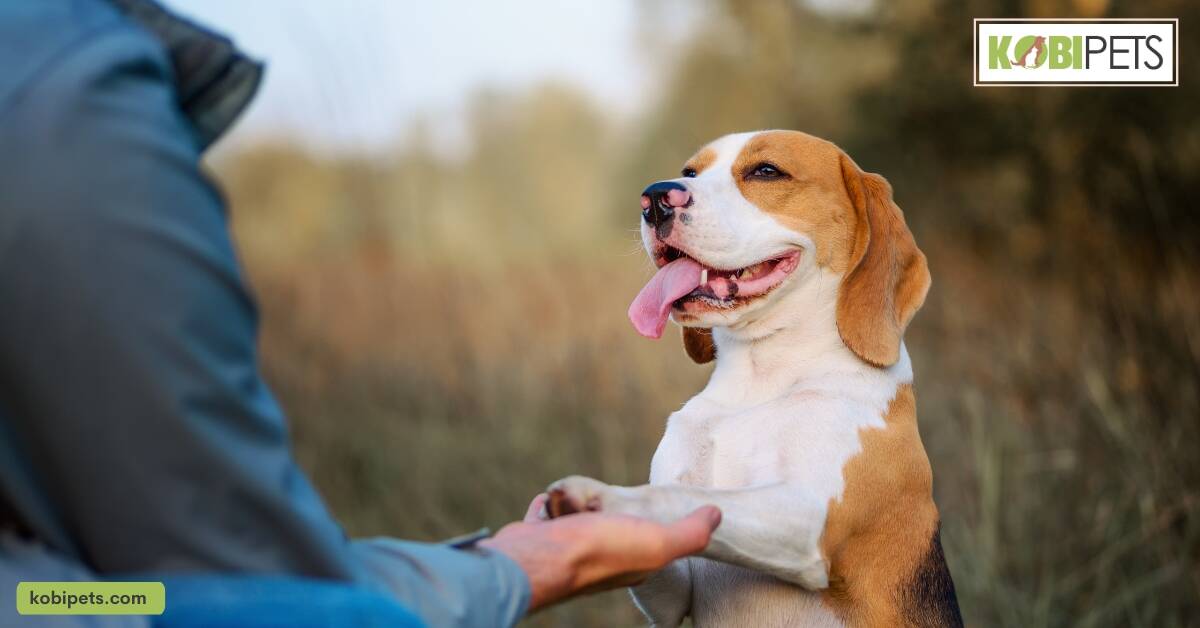
Reinforcing alternative behaviors
Reinforcing alternative behaviors is an important aspect of training a dog to prevent jumping. This involves teaching your dog new behaviors that are more appropriate and safer than jumping.
By rewarding these alternative behaviors, you are encouraging your dog to repeat them instead of jumping. Here are some alternative behaviors you can reinforce:
- Sitting: Teach your dog to sit when greeting people or other dogs instead of jumping. Reward your dog with treats and praise when they comply.
- Eye contact: Encourage your dog to make eye contact with you instead of jumping. This can be done by holding a treat near your face and rewarding your dog when they look at you.
- Shake or high-five: Teach your dog a new trick, such as shaking or giving a high-five, that they can use to greet people instead of jumping.
- Going to a mat or bed: Train your dog to go to a designated mat or bed when they become excited or need to calm down. Reward your dog with treats and praise when they comply.
When reinforcing alternative behaviors, it’s important to reward your dog immediately and consistently. This will help your dog to associate the desired behavior with a positive outcome and will increase the likelihood that they will repeat the behavior in the future.
In summary, reinforcing alternative behaviors is an effective way to train a dog to stop jumping. By teaching your dog new, appropriate behaviors and rewarding them consistently.
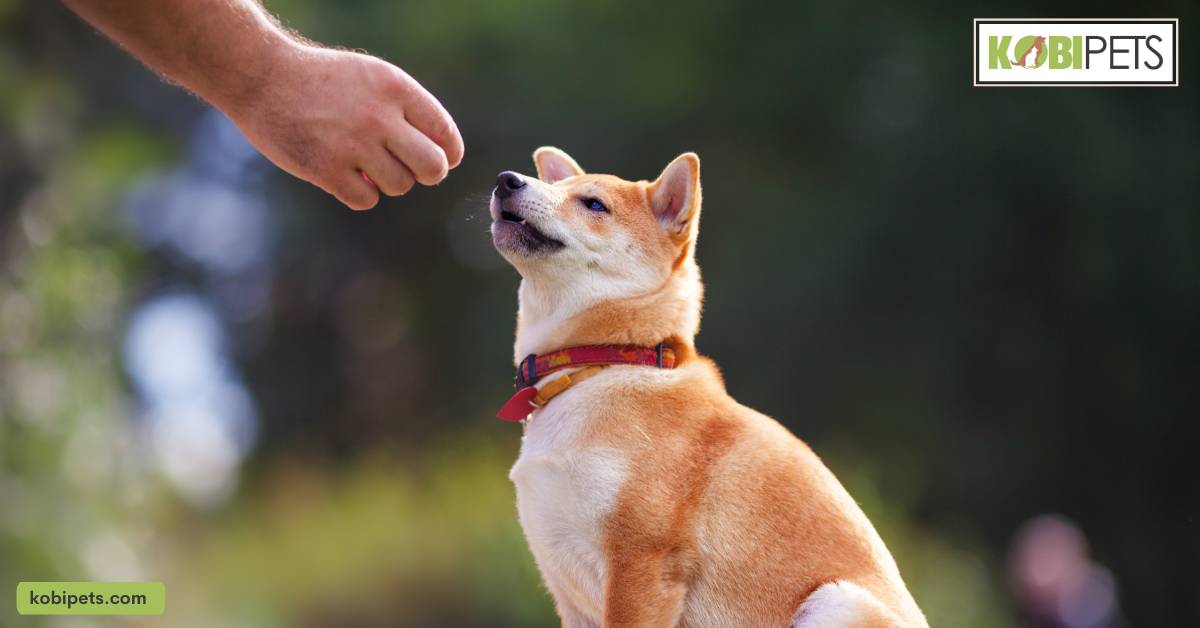
Socializing your dog
Socializing your pup is an important part of training to prevent jumping. Socialization helps your dog understand how to behave around people and other animals. It can help curb the instinct to jump in order to get attention or meet new friends.
When socializing your pup, make sure you do it responsibly. It should be in a controlled setting such as an obedience class or dog park. They can learn to interact without jumping on people.
Introduce your pup slowly and make sure everyone is aware of the expectations for behavior, such as no jumping. Provide positive reinforcement when appropriate and look out for signs that may indicate your pup is uncomfortable or anxious in certain situations.
Regular socialization will help your pup understand proper manners around others and help prevent jumping.
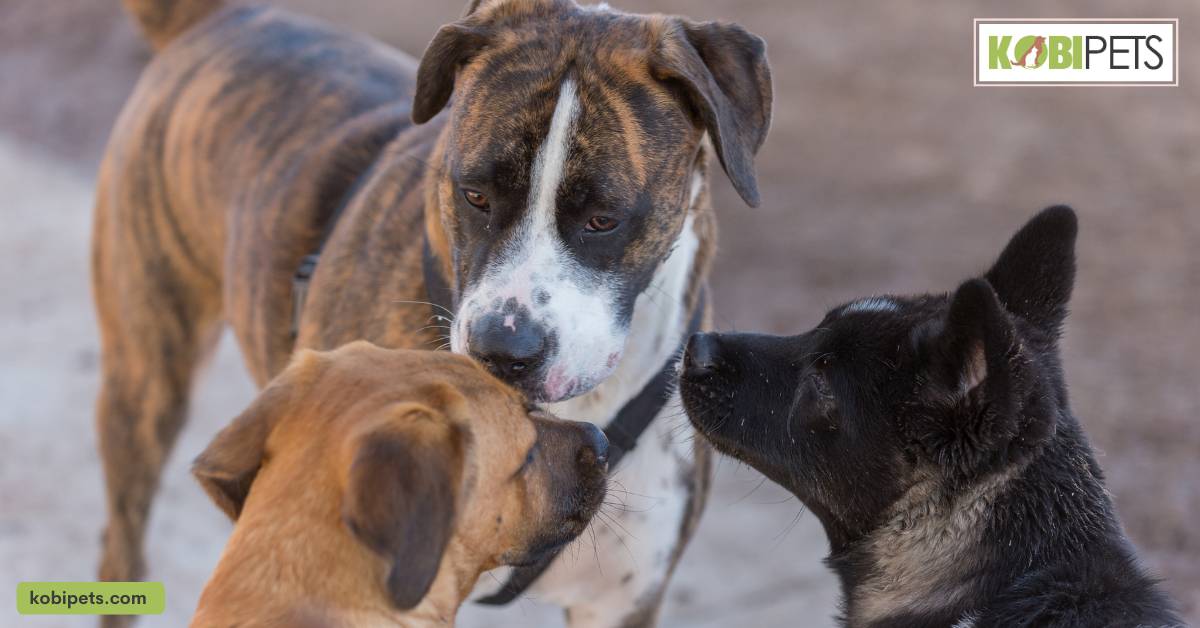
In conclusion
It is important to remember that when your dog jumps is not a sign of affection or enthusiasm. Instead, jumping is a form of dominance and territoriality.
It can be detrimental to both the pet-owner relationship and any other human interactions your dog experiences.
The best way to prevent your pup from jumping is by giving him positive reinforcement for never jumping. Redirect his attention away from the person he wants to jump on.
Reward him with treats for successfully not jumping, and create consistent boundaries within the home. Taking these steps will help to change your dog’s behavior for the better.






